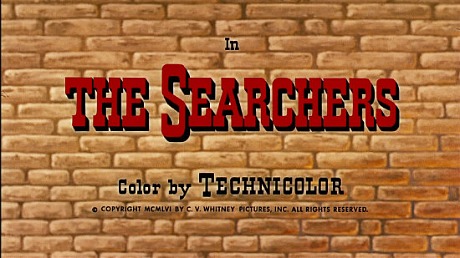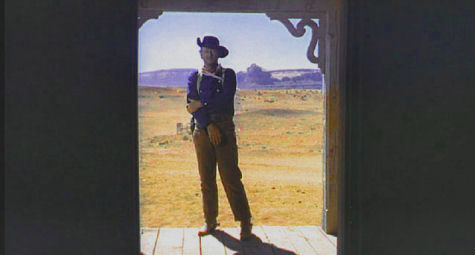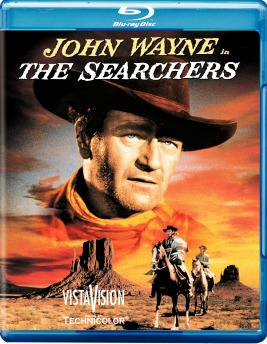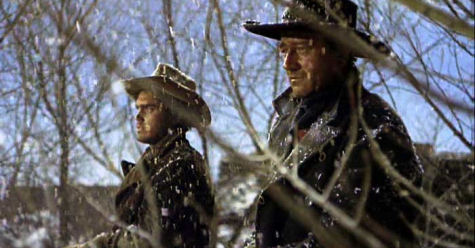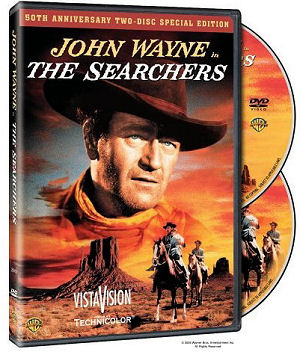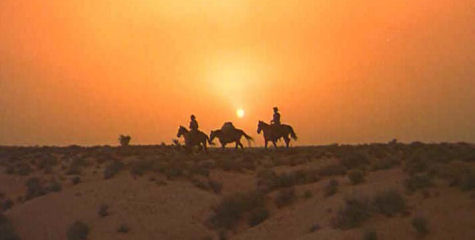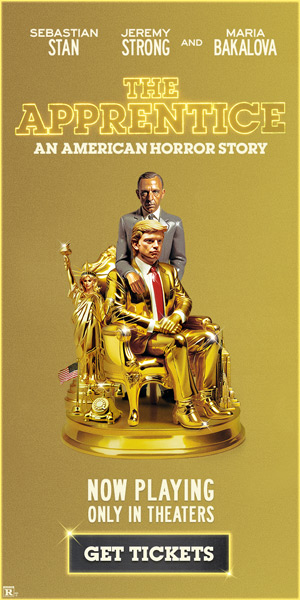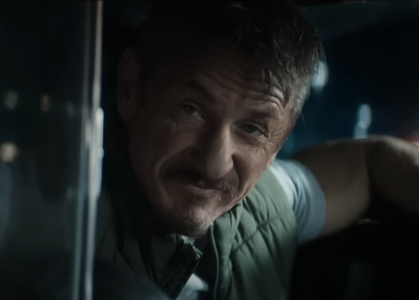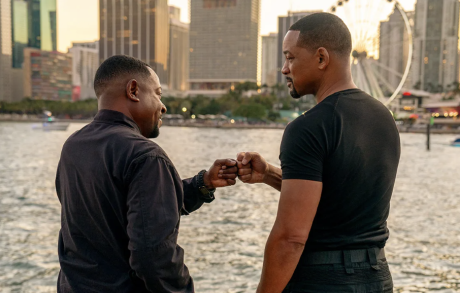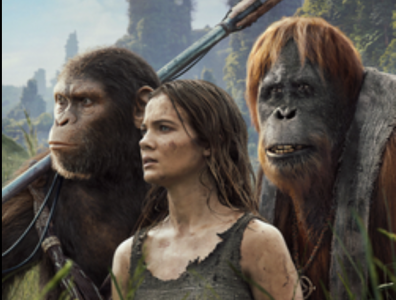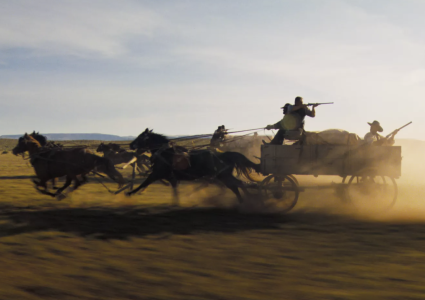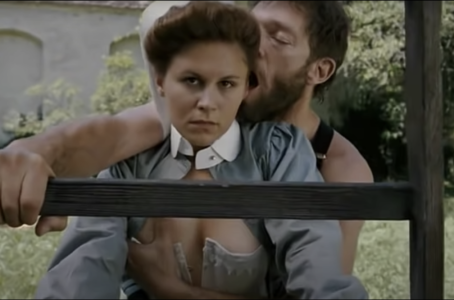Regarding Violence
If you’ve seen David Cronenberg’s A History of Violence, you know it’s a philoso- phical double-dealer, and this is what makes it a complex, cut-above film. It’s not just saying violence is a kind of terrible virus — it’s also saying it has a way of turning us on.
When Jack (Ashton Holmes), the son of cafe owner Tom Stall (Viggo Mortenson), defuses a potentially violent encounter with a school bully by sarcastically acknow- ledging the other guy’s alpha male superiority, etc., you admire Jack for being a hip and clever guy.
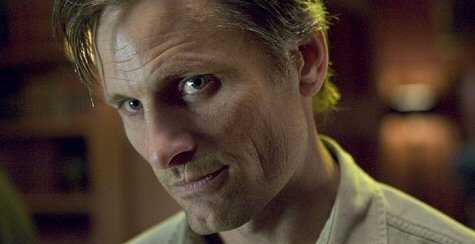
Viggo Mortenson as small-town nice guy Tom Stall in David Cronenberg’s
A History of Violence But when they meet a second time and Jack, inspired by his father’s having become a hero because he killed a couple of bad guys, wails on the bullies and leaves them bruised and groaning, several people in the theatre (at L.A.’s Grove plex) were clapping and whoo-whooing.
Is there anyone out there who thinks Cronenberg didn’t deliver this scene in just the right way so he would get this reaction?
And of course, the steam that comes hissing out of Edie Stall (Maria Bello) isn’t just about feelings of betrayal.
< ?php include ('/home/hollyw9/public_html/wired'); ?>
Edie is furious, naturally, when she realizes her husband has been lying to her for years about his past. But when she and Tom have that end-of-Act-Two fight and she goes “fuck you, Joey” and walks off and Tom grabs her by the ankle and they do that thing on the stairs (a scene that wasn’t scripted, by the way…it just “hap- pened” when they shot it), it’s obvious that Tom’s killer moves have lit a fire in someone’s furnace.
And yet the violence that has happened has obviously stunned and hurt this family of four. In that haunting final scene, Cronenberg shows us that Jack and his younger sister are willing to forgive and forget as they offer food to Tom, but there’s not much assurance that things will henceforth be fine…Cronenberg leaves us in limbo.
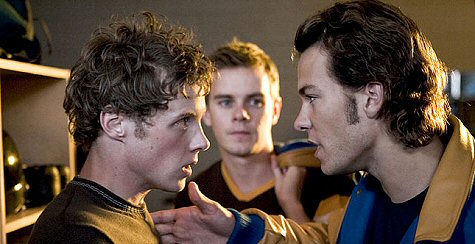
Jack Stall (Ashton Holmes) and the high-school baddies
That’s filmmaking, pally. Lob the ball to the audience in the final frame and let them sort it all out…nice.
One beef with this film: Peter Suschitzky’s cinemography looks like it was soaked in Bolivian coffee during lab processing. I started to wonder if the projector lamp at the Grove’s theatre #1 was dying, but the lamps in the other theatres were fine. The last film I remember being this muddy-looking was Fight Club.
Knockout
I liked so many films in Toronto I was looking forward to trashing two or three upon my return to Los Angeles. So to get things rolling I went to a screening last night (Thursday, 9.22) of Rodrigo Garcia’s Nine Lives (Magnolia) and…shit, another good one.
It’s nine interwoven shorts about women in relationships that aren’t really working, relationships they’d like to be rid of on one level but can’t quite extricate themsel- ves from, and what’s holding them.
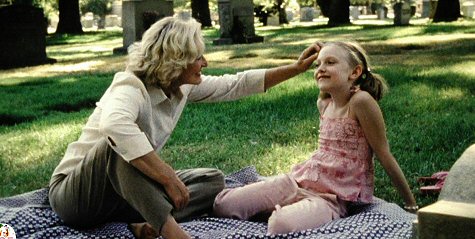
Glenn Close, Dakota Fanning in Rodrigo Garcia’s
Nine Lives (Magnolia)
Each story is a part-muddle, part-riddle and a fascinating drill into some aroused places in the heart, and five out of the nine are direct hits.
I’ve now seen two dramas over the last week and a half about female turmoil and tough choices, but which operate well beyond the usual chick-flick realm….this and In Her Shoes.
Nine Lives played Sundance last January and then the L.A. Film Festival three months ago…why haven’t I heard anything? Am I alone on this one? I don’t care.
Once again we have a south-of-the-border director — Rodrigo Garcia, a colleague of the great Alejandro Gonzalez Innaritu — hitting the ball deep into left-center field and scoring a ground-rule double, if not a triple.
Nine Lives isn’t quite a homer but it’s much better than I expected. It has that same connective-tissue, life-is-short, death-is-just-around-the-corner thing that we’ve all gotten to know through Innaritu’ Amores Perros and 21 Grams.
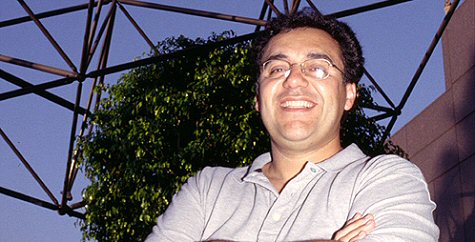 Nine Lives
Nine Lives director-writer Rodrigo Garcia
Neither Innaritu or his screenwriting partner Guillermo Ariagga (who also wrote The Three Burials of Melquiades Estrada) have a co-writing credit, but they might as well have. Garcia is clearly coming from the same place…another Mexican heavy- cat soul man.
Garcia’s writing and the acting are exceptional all through it, and there are two pieces in particular about obsessive sexual love that knocked me on the floor.
The best of the two costars Robin Wright Penn and Jason Isaacs. Set entirely in the aisles of an L.A. supermarket, it’s a marvel of tight writing, dancing camera work, perfectly-pitched acting and emotional sizzle.
The other is a fascinating piece about a woman (Amy Brenneman) and her father attending a funeral of a woman who’s committed suicide, and the soon-enough realization that the woman is a former wife of the deceased woman’s deaf husband (William Fichtner), and that their attraction is not only still going on but may have pushed the wife into suicide, and that their feelings are so urgent that Brenneman and Fichtner can’t help finding a private room and closing the door.
I don’t know which of the two is more of a jaw-dropper, but together they’re worth the admission, the popcorn and having to watch the ads before the trailers.
There are at least three other strong entries. About a financially struggling, clearly frustrated 40ish couple (Stephen Dillane, Holly Hunter) visiting a couple (Isaacs again, Molly Parker) they believe to be on a happier, more comfortable plane. About a terrified wife (Kathy Baker) preparing for breast-removal surgery and bitching at her husband (Joe Mantegna) as she works through her feelings. And about a loving mother (Glenn Close) and her young daughter (Dakota Fanning) visiting a graveyard.
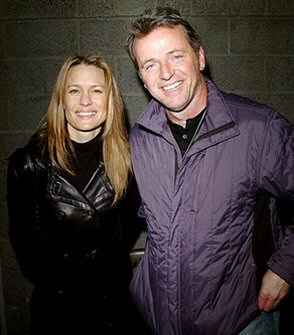 Nine Lives
Nine Lives costars Robin Wright Penn, Aidan Quinn at last January’s Sundance Film Festival
The cast also includes Elpidia Carillo, Lisa Gay Harden, Ian McShane, Mary Kay Place, Sydney Tamiia Poitier, Aidan Quinn, Miguel Sandoval, Amanda Seyfried and Sissy Spacek.
The other four are decent, good enough, carry the ball, etc. A movie like this is like a relay race. Not every segment can bring the fans to their feet.
Nine Lives will open in Los Angeles and New York on 10.14, and will start fanning out the following week.
Moonlighting
After seeing A History of Violence at the Grove, I went to see Kate Krystowiak’s Aftermath, a 28-minute short that she stars in and wrote the script for, at the Laemmle Fairfax last night (9.24).
An above-average effort, it’s an emotionally upfront piece about a romantically impressionable woman named Sara who suffers an emotional bruising from an attractive young guy who moves into her place. The hurt is a result of your typical modern-asshole-boyfriend tendencies (egotism and an inability to share intimacy, for the most part), but also from Sara’s willingess to turn a blind eye at the get-go.
Aftermath could stand some tightening and re-shuffling here and there (film festi- vals don’t like shorts that aren’t 15 minutes long or less), but the hurt that comes out of Krystowiak’s Sara character feels very real.
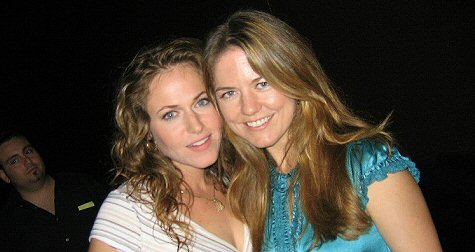 Aftermath
Aftermath editor Teresa Bianca Sciortino, star-writer Kate Krystowiak at Guys — Saturday, 9.24, 12:25 am. The film’s director, Jon Palardis, is visible to the left.
There are two things missing: hot sex and empathy for Sara. There’s a revelation near the end that the boyfriend (Charlie Capen) talked about himself incessantly during their first date and didn’t ask Sara a single question….hello? This is the kind of guy a girl might want to rape or have an affair with, but move in with…?
An audience will empathize with the participants in an ill-fated relationship if it’s about fantastic Olympic-level schtupping, but it’s hard to put yourself in the shoes of a character who ignores warning signs as blatant as the one referred to at the end of this film…sorry, but that’s a fact.
Krystowiak has a quality when she’s confident enough to just be still and let what seems like a kind of natural Polish sadness in her leak out. She needs to just “be.” She has a kind of eastern-European, slightly off-pretty soulfulness…and the less she smiles and tries to sell her perkiness, the more this comes through.
Krystowiak needs to be brought out by a director with the chops of a Krzysztof Kieslowski or a Jerzy Skolimowski. She could have nailed Jane Asher’s part in Deep End, or been the sensuous-girlfriend-in-the-TV-screen in Skolimowski’s Moonlighting.
There was an okay after-party at Guys, a bar right between Jerry’s Deli and Dom- inick’s on Beverly near San Vicente. $10 bucks to get in, $10 bucks a drink… fuck…but it’s mostly an outdoor back-patio thing and I’d be lying by omission if I didn’t say that a very high percentage of the women were drop-dead gorgeous.
Where’s the Bite?
The Academy people who will vote for the Best Feature Doc are thought to be into “bite.” Okay…but how does that square with the general feeling that March of the Penguins, a doc so without bite it could be said to be all gums, is favored to win?
And if weren’t for this ice-frosted Waiting-for-Godot movie, the big favorite would probably be Mad Hot Ballroom, and how “bite” is that? Cute fifth-graders learning to dance and romance and grow up…?
 Murderball
Murderball I know it’s a crying shame that Eugene Jarecki’s Why We Fight, my hands-down choice for the year’s best documentary, is out of the game in part because it aired twice on England’s BBC 4 on 3.23.05.
A brilliant summation on the militant tendencies of U.S. foreign policy over the past 60 years, Why We Fight had a one-week Academy qualifying run in a Marina del Rey theatre last August, and the Academy rulebook states that “no type of tele- vision or internet transmission shall occur at any time prior to the first day of the Qualifying Exhibition”…so that’s that.
I’ve heard that Jarecki has an argument with the Academy…something about a vaguely-worded announcement about a rule-change, which led to a misunder- standing about the allowability of the BBC airing…or some such shit. I called Jarecki four times yesterday to get into it, but he didn’t get back.
On Friday morning I read in a Gregg Kilday piece in the Hollywood Reporter that Why We Fight has also “been ruled ineligible because it has had at least three TV airings in Norway, Sweden and Finland.”
What other docs might wind up nominated? I mean, if you give a shit about this stuff. I’m right on the verge of not caring. It’s also my life, my strife…I shouldn’t admit to this.
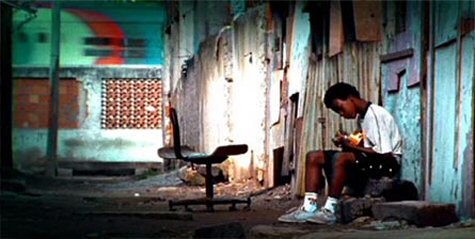 Favela Rising
Favela Rising Naturally, obviously, incontestably…Penn Jillette and and Paul Provenza’s The Aristocrats, a doc that people saw and got all over and kept playing and playing, mainly (I think) because it works on at least three different levels, being (a) funny, (b) appalling and yet a surprisingly warm “family film,” and (b) an educational riff about the nature of creativity. It was such an obvious choice I forgot to put it into this piece when I wrote it late yesterday.
I also forgot to mention Werner Herzog’s Grizzly Man (Lion’s Gate)…I must have a screw loose. It’s only one of the year’s best films bar none.
Alex Gibney’s Enron: The Smartest Guys in the Room…right? Smart, sharp, hard-driving, amusing…important subject, well-reviewed…gotta be there.
And Murderball, of course. Original, intense, fierce…the rumble spreading for the last few months…it’s sunk in to the level where even Academy people are hearing it…Murderball-it.
And Marc Levin’s Protocols of Zion, a 93-minute doc about anti-Semitism and the post-9/11 scattershot blame game.
And David LaChappelle’s Rize, about the South Central dance thing…I guess. I’m not feeling the energy right now, but that’s just me.
A Brazilian doc called Favella Rising might cause a stir. It’s about a onetime drug-dealer named Anderson Sa who evolved into a kind of Malcolm X-like social revolutionary… leading a rebellion against “teenage drug armies and sustained by corrupt police,” blah blah….fine.
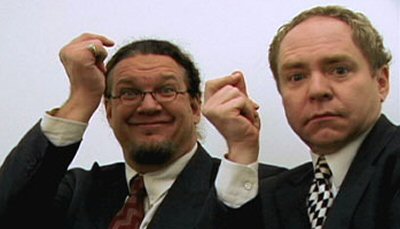
Penn and Teller delivering the now-infamous, staggeringly unfunny punch line.
And I’m told that Darwin’s Nightmare could register. A doc on the effect of fishing the predatory Nile perch in Tanzania’s Lake Victoria…hmmm. A metaphor about voracious appetites of all shapes and origins.
If Martin Scorsese’s No Direction Home: Bob Dylan had cared to qualify itself (i.e., by playing in some obscure New York or Los Angeles theatre last March and then going with the PBS airing and DVD release six months later), it would almost certainly be one of the five. This is a film with bite, snap, brass and bazookas.
This Is Bad
I can’t overstate what a besotted, drugged-out feeling it is to be back in Los Angeles…to once again stand on the roof of a certain West Hollywood high-rise and smell the faintly noxious air and gaze out at the milky haze and tell myself, “It’s okay…despair not.”
There is only way to live in this town and that’s to crawl into the cave of your own head and your work, and to feed off screenings and DVDs and the faces and bodies of pretty women, and to savor those special times in which you happen to be in the company of similarly diseased and/or disgruntled persons like myself.
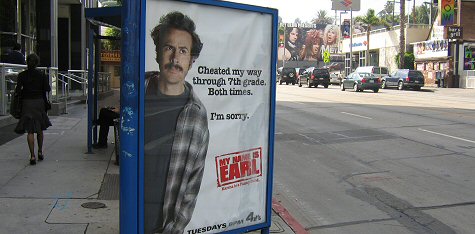
Sunset Boulevard in West Hollywood — Tuesday, 9.20, 1:40 pm.
Like, for instance, the amazing Joss Whedon.
I would find it astonishing to find myself in the pasta-and-sauces department of Pavilions and all of a sudden…Whedon! Just standing there in boring clothes like a regular mortal and telling himself, “I can’t eat pasta any more, certainly not in the evening. Face it — those days are over.”
A portion of my L.A. lethargy is indicated by the fact that I’m back to reading Defamer and going “hyeh-hyeh” like Beevis and Butthead. I didn’t go to Defamer once during the Toronto Film Festival, and not all that much when I was living in Brooklyn. I like Defamer — it’s a very well-written thing and a necessary component — but you have to be a little sick in your soul to be into it in the first place.
I could feel the old vibe swirling around me like that banshee from Darby O’Gill and the Little People, so I did the sensible thing and evacuated myself off the roof of the high-rise and made my way over to Tower Records and bought the DVD of No Direction Home: Bob Dylan.
I tried to wangle a freebie from the Paramount Home Video publicist who took Martin Blythe’s place, but she didn’t call back until today. I tried to buy it yesterday at Laser Blazer in the early afternoon, only to be told it had sold out. The Tower Video guys, who had plenty of copies, said it was moving moderately well but nothing to write home about.
I nodded off for about 20 minutes when I saw David Cronenberg’s A History of Violence in Cannes and I didn’t get around to it in Toronto, so tonight I get to absorb the whole thing at the American Cinematheque, more or less alert…down for it.
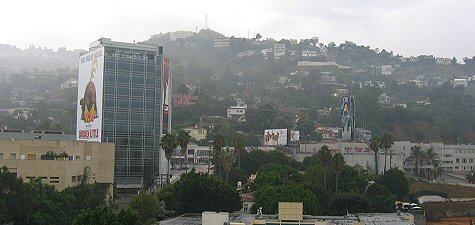
Looking due north from the roof of a condo building at Alta Loma and Holloway — Tuesday, 9.20, 8:45 am.
That means blowing off the all-media of Flightplan, but sometimes you just have to say no.
I’m a little surprised to be riffing rather indulgently about the stink of Los Angeles seeping back into my bones (that’s a Charles Bukowksi line), and I promise to get back into matters of substance fairly soon.
Except melancholia is a matter of substance if you live here.
I’ve got a screening conflict next Tuesday evening — Tony Scott’s Domino vs. Joss Whedon’s Serenity. Well, not really. I would be squirming a bit if Whedon and I were talking in the pasta-and-sauces aisle right now and he was asking me, “So, are you going?”…but we’re not so I’m cool.
The only thing that gives me concern about Domino is an observation in David Katz’s profile of Keira Knightley in the current issue of Esquire. He says that Domino is “a messy movie, often intentionally, often not.”
Turnaround
For years the notion of Catherine Keener being in this or that film was not, for me, a reason to celebrate. She always seemed to play users, takers, manipulators… usually more pissed off than not.
Not each and every time, but I know this impression started to take hold in the late ’90s. I liked her frustrated actress character in Living in Oblivion back in ’96, but I remember going “whoa” after she played the heartless Maxine in Being John Malkovich.
I forget how many other razor-blade women she played in other films, but it seemed as if there were more than a few.
 Capote
Capote costar Catherine Keener.
Now I feel rather differently, and all due to Keener’s last four roles — Daniel Day Lewis’s would-be signficant other in The Ballad of Jack and Rose, the quip-smart government agent in The Interpreter, Steve Carell’s sweet, spiritually-centered love interest in The 40 Year-Old Virgin, and Harper Lee, Truman Capote’s patient, all-seeing best friend, in Capote.
The Capote performance ought to result in a Best Supporting Actress nomination. It really and truly should — I can’t imagine anyone saying “no, I disagree” — and not just because Keener is so moving and touching in this role, but because of her image change.
I’m presuming I’m not the only person with this impression. Keener has always been a “good” actress, but now I think of her in terms of who I perceive her to be possibly be, based on an amalgam of the last four roles.
I was thinking of mentioning this during last night’s discussion at the Los Angeles County Museum’s Leo S. Bing Theatre after a screening of Capote, but it seemed too kiss-assy.
Keener, looking great, was sitting there along with her Oscar-worthy cohorts — director Bennett Miller, Philip Seymour Hoffman (a lock for Best Actor), Clifton Collins, Jr. (near-lock for Best Supporting Actor), and screenwriter Dan Futterman (ditto in the Best Adapted Screenplay category).
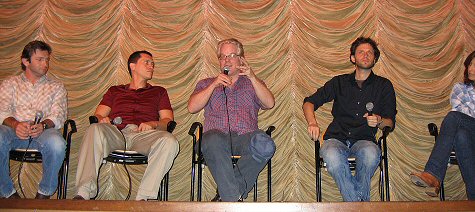
(l. to r.)
Capote screenwriter Dan Futterman, star Philip, costar Clifton Collins, Jr., star Philip Seymour Hoffman, director Bennett Miller, and a portion of costar Catherine Keener at L.A. County Museum’s Leo S. Bing theatre — Tuesday, 9.20, 9:50 pm.
LACMA’s film department head Ian Birnie asked each a single question, and then asked the audience to chime in.
I asked Hoffman and Miller if they had somehow tried to suggest that Hoffman, who’s about 5’10” or so in real life, was closer to Truman Capote’s height of 5’2″. It sure seems this way in the film. They ignored my question, but Miller delivered a good line: “Philip lost 40 pounds and 4 inches for this role.”
I also asked about a little kid whom Capote happens to notice during a brief visit to a grocery store. About three years old, the kid has a toy pistol and does a kind of Diane Arbus-y routine for Capote with two or three grotesque expressions. Miller said this scene was some kind of tribute to Arbus….whatever.
A woman friend who came with me called Capote “one of the best films I’ve ever seen.” It sure as shit is one of the best of the year, a fact expected to be acknow- ledged by the Academy.
Wait a minute…have I said this before?
Shrinking Hoffman
“Since the Capote panelists didn’t answer your question about making Philip Seymour Hoffman appear shorter for his role, I thought I’d offer the following tidbit from our October issue, which offers insights from cinematographer Adam Kimmel:
“‘One overriding concern occupied the filmmakers from start to finish: how to make Hoffman appear as petite as Capote,” it reads. “The actor is 5 or 6 inches taller than the 5’ 2” Capote, and has a broader physique.
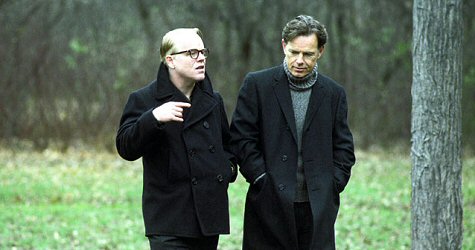 Capote
Capote “‘In testing and during our first week of shooting, we learned which combination of wardrobe, lenses and framing would make Phil appear smaller,’ says Kimmel. ‘To help with the illusion, the actors who shared the frame with Hoffman frequently stood on boxes during stationary scenes, or walked on small, elevated platforms during walk-and-talks.
“The first time Capote and Lee see the Clutter farm, they are shown in a wide shot, with their backs to the camera. Keener, who is roughly the same height as Hoffman, is standing on a box that added 4″ to her height.” — Stephen Pizzello, Executive Editor, American Cinematographer.
Dylan/Scorsese
“You hit it with your words on the Dylan documentary. It’s a great portrait of America by Scorsese, an indisputable version of why Dylan had to crash at the end of that period, and a true inspiration for all of us to keep on and to keep on creating (Dylan being a real example of James Joyce’s description of an artist, one who has to live by ‘cunning and exile.’)
“I’ve been lucky to see Dylan perform a lot, from his comeback tour with The Band in ’75 (still one of the best shows ever) to all three nights that he played last Spring here in St. Louis at a small venue. (Lots of people came to that out of curiousity and were stunned by the music — you could see their respect and joy grow throughout those evenings.)

“He’s an endless source of a rock ‘n roll beat and a poetic charge. I have a new favorite lyric – from one of his songs I didn’t know, ‘Up To Me,’ which is covered on a recent tribute album by Roger McGuinn — ‘I’ve only smiled once in 14 months and I didn’t do it consciously.’
“But along with the interviews in No Direction Home, some of his utterances knock me out as well. When questioned why he agreed to appear along with his sacred music in, of all things, a Victoria’s Secret commercial, he reportedly said, ‘Was I not supposed to do that?'” — Joe Hanrahan.
